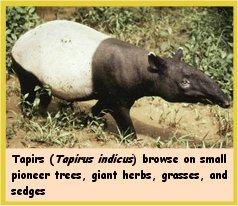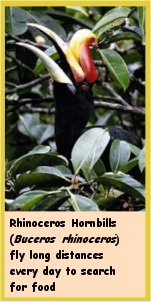
A great diversity of wildlife call the Malaysian lowland rain forest their
home. The mammal fauna is very rich and has more than 200 known species.
This includes elephant, gaur,
tapir,
tiger, bats, squirrels, and deer.
The rare Sumatran
rhino numbering less than 300 worldwide, roams the remote forests.
 The primate fauna is also rich, comprising seven species in Peninsular
Malaysia and a similar number in Sarawak/Sabah. The orang
utan, largest arboreal ape in the world, lives only in the forests
of Borneo and Sumatra. The whooping of gibbons
at dawn is perhaps the most memorable sound of the Malaysian rain forest.
However, they are very shy, and you should consider your visit worthwhile
if you happen to glimpse them.
The primate fauna is also rich, comprising seven species in Peninsular
Malaysia and a similar number in Sarawak/Sabah. The orang
utan, largest arboreal ape in the world, lives only in the forests
of Borneo and Sumatra. The whooping of gibbons
at dawn is perhaps the most memorable sound of the Malaysian rain forest.
However, they are very shy, and you should consider your visit worthwhile
if you happen to glimpse them.


 The Malayan tiger is perhaps the most majestic animal and also very endangered.
There are probably not more than a few hundred left in the Peninsular (tigers
do not occur in Borneo). In comparison with other tiger subspecies, the
Malayan tiger is smaller in stature due to adaptations over the millennia
to survive in this hot, humid environment. Its main prey are wild pigs
and barking deer.
The Malayan tiger is perhaps the most majestic animal and also very endangered.
There are probably not more than a few hundred left in the Peninsular (tigers
do not occur in Borneo). In comparison with other tiger subspecies, the
Malayan tiger is smaller in stature due to adaptations over the millennia
to survive in this hot, humid environment. Its main prey are wild pigs
and barking deer.
Elephants never fail to arouse attention due to their size and majesty.
In Malaysia, elephant herds are becoming rare due to conversion of their
habitat into oil palm estates. There are two main species, the African
and Asian elephant. Malaysian elephants are the Asian variety with smaller
ears and size. Herds are predominantly female and young calves, led by
a matriach. Bulls lead a solitary life and only mix with the herd during
the mating season. They love palm shoots and this has brought them into
conflict with irate oil palm plantation owners, the result being that many
have been translocated from fragmented forest areas into larger contiguous
protected reserves.
The Malayan tapir is uniquely Malayan and isn't found in Borneo, although
it occurs in certain areas in Sumatra. This is one of the mysteries that
reserchers still haven't unraveled; that although Sumatra, Borneo, and
Peninsular Malaysia were once joined by land during the last Ice Age and
thus share affinities in flora and fauna, the exclusion/inclusion of certain
plant and animal species in the various lands is still something of a mystery.
The black and white markings on the tapir help it to be camouflaged in
the forest even though you may not think so. In fact, experienced trekkers
have been amazed to see what was once a boulder in front of them suddenly
get up and trot off!
 The avifauna
of Malaysia is very rich with more than 660 species from the large Great
Hornbill to the tiny Plain Flower Pecker, Malaysia's rain forests are a
paradise for birdwatchers. In just a few days of observation at a virgin
lowland forest site, as many as 150 species of birds may be observed.
The avifauna
of Malaysia is very rich with more than 660 species from the large Great
Hornbill to the tiny Plain Flower Pecker, Malaysia's rain forests are a
paradise for birdwatchers. In just a few days of observation at a virgin
lowland forest site, as many as 150 species of birds may be observed.
The scope of this website does not permit more the briefest of descriptions
for just a few of the rain forest fauna. Bear in mind that the invertebrate
fauna is extremely diverse, with many more species yet to be discovered.
The insects and other
anthropods may be the only creatures you'll see in the forest, because
most jungle fauna are very shy and avoid man. Many kinds of butterflies,
moths, ants, termites, spiders, beetles, milipedes, etc can be quite easily
observed in a day's walk. Add to that the myriad lizards, snakes, and other
reptiles plus the aquatic fauna like fishes, prawns, and shrimp, etc and
you get a brief picture of the complex biodiversity that exists in Malaysia's
forests. However, the greatest diversity is concentrated in the lowland
dipterocarp rain forests.

 The primate fauna is also rich, comprising seven species in Peninsular
Malaysia and a similar number in Sarawak/Sabah. The orang
utan, largest arboreal ape in the world, lives only in the forests
of Borneo and Sumatra. The whooping of gibbons
at dawn is perhaps the most memorable sound of the Malaysian rain forest.
However, they are very shy, and you should consider your visit worthwhile
if you happen to glimpse them.
The primate fauna is also rich, comprising seven species in Peninsular
Malaysia and a similar number in Sarawak/Sabah. The orang
utan, largest arboreal ape in the world, lives only in the forests
of Borneo and Sumatra. The whooping of gibbons
at dawn is perhaps the most memorable sound of the Malaysian rain forest.
However, they are very shy, and you should consider your visit worthwhile
if you happen to glimpse them.




 The avifauna
of Malaysia is very rich with more than 660 species from the large Great
Hornbill to the tiny Plain Flower Pecker, Malaysia's rain forests are a
paradise for birdwatchers. In just a few days of observation at a virgin
lowland forest site, as many as 150 species of birds may be observed.
The avifauna
of Malaysia is very rich with more than 660 species from the large Great
Hornbill to the tiny Plain Flower Pecker, Malaysia's rain forests are a
paradise for birdwatchers. In just a few days of observation at a virgin
lowland forest site, as many as 150 species of birds may be observed.